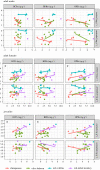Associations between faecal chemical pollutants and hormones in primates inhabiting Kibale National Park, Uganda
- PMID: 37221860
- PMCID: PMC10206455
- DOI: 10.1098/rsbl.2023.0005
Associations between faecal chemical pollutants and hormones in primates inhabiting Kibale National Park, Uganda
Abstract
While anthropogenic pollutants are known to be a threat to primates, our understanding of exposure to pollutants in situ and their sub-lethal effects is still limited. We used non-invasive biomonitoring to examine associations between faecal concentrations of 97 chemical pollutants and faecal hormone metabolites of cortisol and oestradiol in four primate species inhabiting Kibale National Park, Uganda (chimpanzees-Pan troglodytes, olive baboons-Papio anubis, red colobus-Piliocolobus tephrosceles and red-tailed monkeys-Cercopithecus ascanius). Across all species (n = 71 samples), results demonstrated positive associations of organochlorine pesticides (OCPs) (β = 0.143, p = 0.020) and organophosphate esters (β = 0.112, p = 0.003) with cortisol in adult females. Additionally, we observed positive associations of OCPs (β = 0.192, p = 0.013) and brominated flame retardants (β = 0.176, p = 0.004) with cortisol in juveniles. Results suggest that cumulative pesticides and flame retardants are disruptive to endocrine function in these populations, which could have implications for development, metabolism and reproduction. Our study further demonstrates that faeces can be an important, non-invasive matrix for examining pollutant-hormone associations in wild primates and other critical wildlife populations.
Keywords: endocrine disruption; flame retardants; persistent organic pollutants; pesticides; wildlife toxicology.
Conflict of interest statement
We declare we have no competing interests
Figures
References
-
- Fairbrother A. 2003. Lines of evidence in wildlife risk assessments. Hum. Ecol. Risk Assess. 9, 1475-1491. (10.1080/10807030390250958) - DOI
-
- Munns WR Jr. 2006. Assessing risks to wildlife populations from multiple stressors: overview of the problem and research needs. Ecol. Soc. 11, 23-35. (10.5751/ES-01695-110123) - DOI
Publication types
MeSH terms
Substances
Supplementary concepts
Associated data
Grants and funding
LinkOut - more resources
Full Text Sources
Medical


